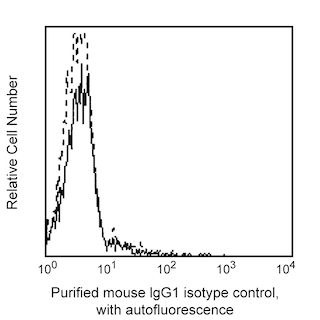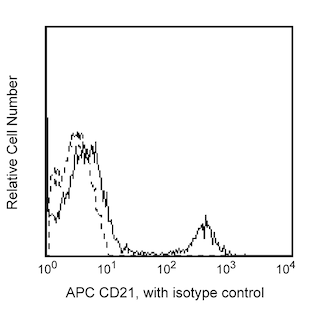Old Browser
Looks like you're visiting us from {countryName}.
Would you like to stay on the current country site or be switched to your country?




Flow cytometric analysis of CD21 expression on human peripheral blood mononuclear cells (PBMC). PBMC were stained with either Purified Mouse Anti-Human CD21 (Cat. No. 552727, shaded histogram) or Purified Mouse IgG1, κ Isotype Control (Cat. No. 552727, open histogram), followed by FITC Goat Anti-Mouse Ig (Cat. No. 554001). The histograms were derived from the gated events based on light scattering characteristics of viable lymphocytes.


BD Pharmingen™ Purified Mouse Anti-Human CD21

Regulatory Status Legend
Any use of products other than the permitted use without the express written authorization of Becton, Dickinson and Company is strictly prohibited.
Preparation And Storage
Recommended Assay Procedures
Immunofluorescent Staining and Flow Cytometry: The 1048 antibody is useful for flow cytometric analysis of CD21/CR2 expressed on cell surfaces. Double staining PBMCs with clone 1048 and BD Biosciences Pharmingen's other CD21 specific clone, B-ly4 (Cat. No. 559867) reveal up to 98% identity of the positive population, indicating that these two clones recognize different epitopes of CR2 (data not shown).
Product Notices
- Since applications vary, each investigator should titrate the reagent to obtain optimal results.
- An isotype control should be used at the same concentration as the antibody of interest.
- Caution: Sodium azide yields highly toxic hydrazoic acid under acidic conditions. Dilute azide compounds in running water before discarding to avoid accumulation of potentially explosive deposits in plumbing.
- Sodium azide is a reversible inhibitor of oxidative metabolism; therefore, antibody preparations containing this preservative agent must not be used in cell cultures nor injected into animals. Sodium azide may be removed by washing stained cells or plate-bound antibody or dialyzing soluble antibody in sodium azide-free buffer. Since endotoxin may also affect the results of functional studies, we recommend the NA/LE (No Azide/Low Endotoxin) antibody format, if available, for in vitro and in vivo use.
- Please refer to www.bdbiosciences.com/us/s/resources for technical protocols.
Companion Products



.png?imwidth=320)

CD21 is a 145 kDa transmembrane glycoprotein that is expressed on mature B cells, follicular dendritic cells, a subset of immature thymocytes and on some epithelial cells. CD21 is also known as the C3d Receptor, Complement Receptor 2 (CR2), and the Epstein-Barr Virus receptor, (EBV-R). CD21 is part of a large signal-transduction complex that also includes CD19, CD81 and Leu13. CR2 serves as a receptor for the activation fragments of complement component C3, i.e. C3d, iC3d, and C3dg and C3d-bound antigens and plays a central role in the immune response by amplifying B-cell activation and proliferation. CR2 is also the receptor for EBV by binding its surface glycoprotein gp350/220. Anti-human CR2 hybridomas were generated from Cr2-/-mice (lacking the cr2 gene, that encodes CR2 and CR1 in mice) immunized with the recombinant protein representing the first two amino-terminal short consensus repeats (SRC) of human CR2, SCR1-2. Both the C3d and EBV binding sites of hu CR2 were localized to these sites. Clone 1048 has been reported to specifically react with CR2-expressing cells and to inhibit CR2 interactions with C3 fragments or the EBV surface protein, gp350/220.
Development References (4)
-
Carel JC, Myones BL, Frazier B, Holers VM. Structural requirements for C3d,g/Epstein-Barr virus receptor (CR2/CD21) ligand binding, internalization, and viral infection. J Biol Chem. 1990; 265(21):12293-12299. (Biology). View Reference
-
Cooper NR, Moore MD, Nemerow GR. Immunobiology of CR2, the B lymphocyte receptor for Epstein-Barr virus and the C3d complement fragment. Annu Rev Immunol. 1988; 6:85-113. (Biology). View Reference
-
Guthridge JM, Young K, Gipson MG, et al. Epitope mapping using the X-ray crystallographic structure of complement receptor type 2 (CR2)/CD21: identification of a highly inhibitory monoclonal antibody that directly recognizes the CR2-C3d interface.. J Immunol. 2001; 167(10):5758-66. (Biology). View Reference
-
Szakonyi G, Guthridge JM, Li D, Young K, Holers VM, Chen XS. Structure of complement receptor 2 in complex with its C3d ligand. Science. 2001; 293(5522):1725-1728. (Biology). View Reference
Please refer to Support Documents for Quality Certificates
Global - Refer to manufacturer's instructions for use and related User Manuals and Technical data sheets before using this products as described
Comparisons, where applicable, are made against older BD Technology, manual methods or are general performance claims. Comparisons are not made against non-BD technologies, unless otherwise noted.
For Research Use Only. Not for use in diagnostic or therapeutic procedures.
Refer to manufacturer's instructions for use and related User Manuals and Technical Data Sheets before using this product as described.
Comparisons, where applicable, are made against older BD technology, manual methods or are general performance claims. Comparisons are not made against non-BD technologies, unless otherwise noted.